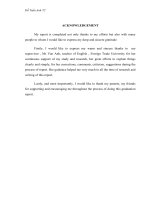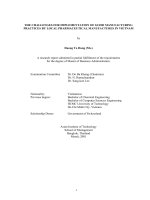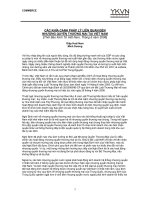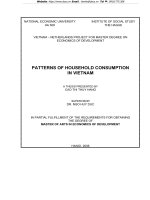LANDSLIDE DISASTER IN VIETNAM
Bạn đang xem bản rút gọn của tài liệu. Xem và tải ngay bản đầy đủ của tài liệu tại đây (6.72 MB, 29 trang )
DRC Project:
LANDSLIDE DISASTER IN VIETNAM
Dr. Nguyen Thi Thu Ha
Vietnam National University, Hanoi
LECTURE CONTENT
I.
INTRODUCTION
II.
OVERVIEW OF LANDSLIDE DISASTER IN VIETNAM
III.
THE CASE STUDY OF VULNERABILITY ASSESSMENT
OF LANDSLIDE DISASTER IN BACKAN PROVINCE
TH
LECTURE ON JULY 9 2013
I.
INTRODUCTION
II.
OVERVIEW OF LANDSLIDE DISASTER IN VIETNAM
-
Past and ongoing researches on landslide in VN
-
Landslide disasters distribution
-
Landslide types
-
Causes
-
Mitigation
I.
INTRODUCTION
The term "landslide" describes a wide variety of
processes
thatdisaster”
result in the
downward
and outward
The
“landslide
is the
specific term
of
movement
of vulnerable
slope-forming
materials including
rock,
landslide
that
to residential
lives, goods
soil,destroyed
artificial fill,
or a combination of these.
and
infrastructures
The materials may move by falling, toppling, sliding,
spreading, or flowing (table below).
Types of landslides. Abbreviated version of Varnes'
classification of slope movements (Varnes, 1978).
Where is Vietnam & Why is Vietnam’s landslide?
¾ national land area is highland (85% lower than 1000 m; 1% >2000
m)
Red River Delta
Complex geologic structure + tropical climate thick and
unconsolidated weathering crust
Tropical climate: high occurrence frequency of heavy rain and
Japan
storms/typhoons
Undeveloped economics, low technology and public awareness
high vulnerable to disasters
Vietnam
Estimation: 15 landslide disaster/year with 30 people dead/year,
ITST
Mekong River Delta
February 2012
5 am 16Feb2012, No. 6 Highway, Mai Chau, Hoa Binh Province
2deads, traffic blocked for 10 days
April 2012
5 am 15Apr2012, Phan Me coal mine, Thai Nguyen Province
destroyed 14 houses and 7deads
May 2012
5May2012, Nui Cam, An Giang (Southern Vietnam)
Rock fall, 6 deads
July 2012
26-27Jul2012, Northern Mountainous Areas
destroyed many houses, roads, schools and 11deads
August 2012
11 am 6Aug2012, No34 Highway, Nguyen Binh, Cao Bang
31Aug2012 night, Xat Bat, Lao Cai
2 people dead
10 people dead, destroyed 12 houses
September 2012
9 am 7Sep2012, Mu Cang Chai, Yen Bai Province
29 people dead
October 2012
27-28Octo2012, accompanied by Son Tinh Typhoon
1 people dead, landslide occurred along Ho Chi Minh talus road
Land Subsidence
•
Coal mine in Quang Nam: 2 dead (24/4)
•
Coal mine in Quang Ninh: 1 dead, (21/5)
•
Rock mine in Nghe An: 1 dead, 7 injured (4/7(
•
Gold mine in Tuong Duong, Nghe An: 3 dead, 7 injured
Quang Nam
(17/7)
•
Coal mine in Quang Ninh: 3 dead, 4 injured (23/7)
•
Hydropower cellar in Nam Pong, Nghe An: 1 dead, 6 injured
(19/8)
•
Metal mine in Yen Bai: 17 dead, 3 injured (7/9)
•
Rock mine in Ha Tinh: 1 dead (19/9)
Ha Tinh
Vietnam is one of the most vulnerable countries to the impacts of
climate change. Vietnam loses around 2 per cent of GDP per year as a
result of weather-related disasters. In 2011, natural disasters
Typhoons
occurrence
frequencyand infrastructure with
continued to impact
on Vietnamese
livelihoods
flooding of around 450,000 households, inundation of more than
events
350,000 hectares of rice paddy field, and 295 recorded deaths, with an
landslides
Extreme rainfall increase, even in areas whereMore
total rainfall
decreased
Number of days with Rx ≥ 50 mm (heavy rainfall day)
occurred
estimated damage bill of USD 620 million.
In future, landslides will
occur more frequently with
higher intensity in Vietnam
-
Vietnam is a Southeast Asian country where landslides occurred frequently and in diversiform; Landslide
disasters damaged seriously residential lives, livelihoods and infrastructures;
-
Vietnam is a country most impacted by climate change. This impact was exposed by increasing in intensity and
occurrence frequency of natural disasters, including landslides
Landslide disaster in Vietnam gives a typical lesson for the disaster in ASEAN countries where:
Therefore
-
most areas are featured by sloping terrain and complex geologic structures;
-
socio-economics, technology are underdeveloped
impact and mitigation of disaster are distinguished.
II.
OVERVIEW OF LANDSLIDE DISASTER IN VIETNAM
-
Past and ongoing researches on landslide in VN
-
Landslide types
-
Landslides’ distribution and state
-
Landslides’ incidence and susceptibility
-
Landslides’ causes
-
Mitigations
Past and ongoing researches on landslide in VN
2010–
present:
2000
– 2010:
Natural
hazards/disasters
(landslides)
are getting
and international
NGO’s investment
and
research
and assessment
of landslide
s in a broad
scale government’s
(regional and national
scale) , Institute
of Geological
1990 – 2000:
scientific
interests.
Ongoing
National
Project
and
zoning
of D.
focused
onVietnam
small-scale
landslides
inresearches:
mountainous
area, e.g.:
Lai“Investigating,
Chau
(Minh assessment
V. risk
C. etassessing
al., 1994);
Son
La (Tuyet
Sciences,
Academy
of Science
and Technology:
Project
“Integrated
of geohazards
in
landslide
in 37 mountainous
provinces
in Vietnam”
(MONRE);
Development
Landslide
Riskmapping
Assessment
Vietnam
and mitigations”
(2000-2003);
National
programme
on “Vietnam
natural of
hazards
zoning
“
et al., 1991; 2000); Dak Lak (Du D. K. et al, 1994), Central highland (Yem N.T et al, 1992). Significant outcomes:
alongmaps
Transport
Arteries in
Nam and
(JICA,
Tohoku
(TGU)
and VMOT);
(2003 Technology
– 2006) series
of geohazards
in Viet
Vietnam
pilot
sites Gakuin
at scaleUniversity
of 1:50.000;
landslides
of Ho
land subsidence zoning map, scale 1:2.000.000 (Son N. T. et al., 1996); landslide risk possibility zoning map for
“Capacity
Building
Mitigation
and Hochiminh
Adaptation branch
of Geodisasters
Related
to Environment
Energy
Chi Minh
road talus
(2005for
– 2009)
by VNU,
landslide
distribution
and state and
, main
the Northern
West region;
the Northern
East
region; Collaboration
Central highland
regionVNU)
at scale of 1/500.000 territorial
in Vietnam”
(Vietnam
– Norway
project,
causes,Development
technical mitigations
planning, unpublished data, ministerial storages.
Landslide research challenges in Vietnam:
-
Lack of published and exchanged data
-
Lack of modern methods and techniques
-
Almost researches are theoretical approach/ inapplicable approach
-
Mitigations are not concrete
Promising research topic in Vietnam
Landslide types
Northern Mountainous Area
60-70
Rock mines (Central part)
5-10
10-20
Northern Mountainous Area
1-5
Hanoi, Vinh Phuc, coal mines
Keller A., 2011
Slides:
-
Small scale: widespread in Northern and Central mountainous area,
particularly along the roads (transport arteries).
-
3
Medium scale (100 - 1000 m ): in mining areas (tailings, soil-dumps).
Quang Ninh 2011
-
3
Large scale (>1000 m ): debris flows.
Ha Giang, 7/2008
Hai Van mountain-pass, No. 1 Highway
Yen Bai, 2012
Phan Me, 2012
Cho Ra, Bac Kan Province
Flows: accompanied with flash floods and heavy rains
Falls: rock mines
Subsidence: Road, Karst
6/2013 Thanh Hoa
Quang Nam,
2011 8/2012
Hanoi,
Phu Tho 4/2012
Quang Ninh, 1/2011
Ha Giang,Da
6/2012
Nang 9/2011
Landslides’ distribution and state
Very high
Residential areas: Mountainous residential districts (Son La, Lai Chau, Yen
Bai, Ha Giang), accompanied with flash floods. Main type: debris flow
Reservoirs areas: Hoa Binh, Son La, Central Highland, medium scale, all
medium
types
Mining areas: rock mines (Thanh Hoa, Nghe An, Da Nang); coal mines
high
(Quang Ninh, Thai Nguyen), gold and other metals (Yen Bai, Hoa Binh, Bac
Kan). Main type: falls, subsidence
Along transport arteries: along No. 6, No. 1 (Hai Van), along Ho Chi Minh
road, along No. 4, No. 2 high ways. Main type is Slides at small scale
low
Landslides’ incidence and susceptibility
-
35 people dead/year (excluding by debris flows)
-
Hundred houses destroyed/year
-
Hundreds road kilometers were destroyed/year, many bridges and
underground projects were damaged
-
Huge budget amount for landslide disasters recovery
-
Residential/social mentality
Ho Chi Minh city, 2010
The dead by landslide in Quang Nam, 2009
Ho Chi Minh road
Damage to residences from landslides in Son La, Son La Province, Vietnam
Landslide on National Highway No. 1 (in Central Vietnam)
Landslides disasters’ causes
Geologic structure and processes: deep and active faults, thick and
strong deformed rock formations
Topographic structure: slope. steep
Climate: tropical, warm and heavy rain
Policy: weak, focus on economic development only
Awareness and culture: low, minority groups
Technology: undeveloped









